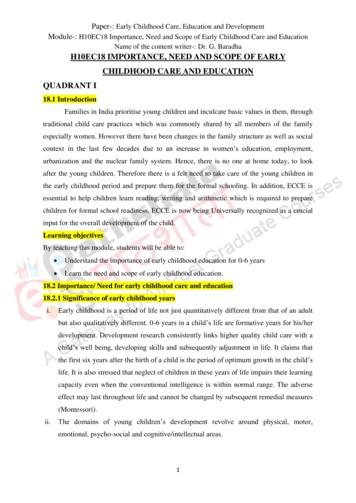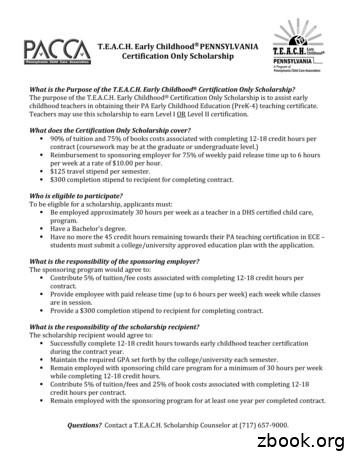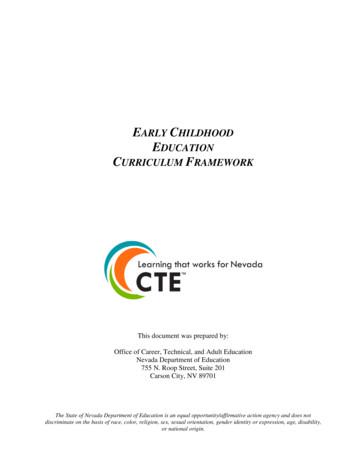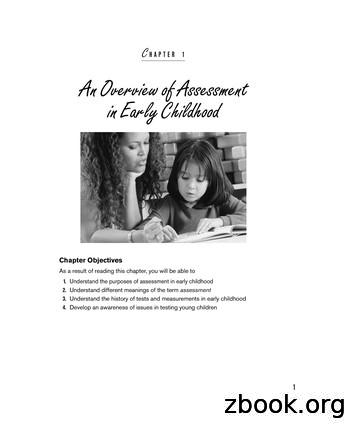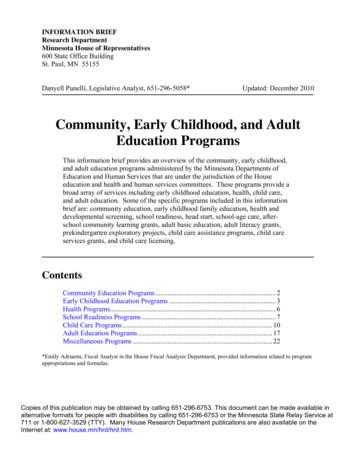EARLY CHILDHOOD (K-3) SYLLABUS - K-10 Outline
EARLY CHILDHOOD (K-3)SYLLABUS
Department of Education and Training, Western Australia, 2007This document contains material developed by the Department of Education and Training, WesternAustralia, for, and on behalf of, the State of Western Australia, which is protected by Crown copyright.Teachers working in Australian schools may save, share and use any part of the material with theirclasses. This permission includes accessing the material or any part of the material and reproducing it,in any form, verbatim or modifying it (apart from third party copyright) and including it in teachers’ ownteaching and assessment programs or for any other purposes in relation to their teaching duties at theirschool. This permission does not allow teachers working in Australian schools to make any charge forproviding the material or any part of the material to another person or in any way make commercial useof the material or any part of the material without the prior written consent of the Department of Educationand Training and payment of the appropriate copyright fee. This permission is provided for teachersworking on an individual basis or when they are working together with colleagues but is not provided foreducation departments or other systems of schools. Education departments or other systems of schoolswishing to reproduce the material or any part of the material on any systemic basis, must request thewritten permission of the Department of Education and Training.All other intellectual property rights and, rights in relation to parties other than teachers working inAustralian schools, are reserved and protected by Australian and international copyright laws.This document may also contain third party copyright materials such as photos, diagrams, quotations,cartoons and artworks. These materials are also protected by Australian and international copyright lawsand may not be reproduced or transmitted in any format without the copyright owner’s specific permission.Third party items are clearly identified and the source acknowledged. Unauthorised reproduction,transmission or commercial use of such copyright materials may result in prosecution.Whilst every effort has been made to ensure the accuracy of the information contained in this publication,no guarantee can be given that all errors and omissions have been excluded. No responsibility for lossoccasioned to any person acting or refraining from action as a result of the material and third partymaterials in this publication can be accepted by the Department of Education and Training.The Department of Education and Training, Western Australia acknowledges the Curriculum Council’ssupport in the development of this document and in providing permission to incorporate into the text ofthis document extracts and summaries from the Curriculum Framework; Curriculum Framework ProgressMaps; Curriculum Framework Curriculum Guides; and the Getting Started, Integrated Learning andLearning Area support documents.Enquiries to:Department of Education and Training151 Royal StreetEAST PERTH WA 6004Website: portal.det.wa.edu.au (Department of Education and Training teachers)k10syllabus.curriculum.wa.edu.auTitle: Early Childhood (K-3) SyllabusSCIS NO.: 1341814ISBN: 978-0-7307-4260-9ISBN-13 978-0-7307-4260-99 780730742609
Table of contents1Purpose of the Early Childhood (K-3) Syllabus2Children’s learning in the early childhood phase of development3Planning for learning in the early childhood phase of development4Content5ReferencesEarly Childhood (K-3) Syllabus1-1
1Purpose of the Early Childhood(K-3) Syllabus1.1 IntroductionThe Early Childhood (K-3) Syllabus isThis syllabus contains information about: children’s learning in the early childhoodphase of developmentdesigned to support early childhood teachersas they meet the learning needs of each planning for learningchild in developmentally and contextually content.appropriate ways.1.2 Connection with othercurriculum policy andsupport documentsKindergarten programs are available tochildren who have turned 4 by 30 June in anygiven year and are offered for the equivalentThe syllabus provides scope and sequenceof 4 half days per week.statements of content that link to theoutcomes in the Curriculum Framework.Pre-primary programs are available tochildren who have turned 5 by 30 June in anyEarly childhood teachers can use thisgiven year. Pre-primary programs are offeredsyllabus in conjunction with the Curriculumfor 5 full days.Framework Curriculum Guides. The Guidesprovide a broad range of content related toYears 1-3 are the beginning years ofoutcomes in the Curriculum Framework. Bycompulsory schooling.using the Guides in conjunction with thissyllabus, early childhood teachers will haveThe Early Childhood (K-3) Syllabus providesaccess to content that meets the learningadvice on content to support developmentneeds and interests of a range of children.of learning in the early years of schooling.Content is expressed at specific yearNational Consistency in Curriculum Outcomeslevels to provide early childhood educators(NCCO) Statements of Learning were agreedwith advice on starting points for theby the Ministerial Council for Education,development of learning programs. It is theEmployment, Training and Youth Affairs inteacher, in partnership with children andApril 2006. These Statements of Learningparents/caregivers, who will continue toprovide a means of achieving greater nationalmake decisions about appropriate learningexperiences for each child.Early Childhood (K-3) Syllabus1-2
consistency in curriculum outcomes acrossthe eight States and Territories. Statements ofLearning have been agreed for the followingareas: Civics and Citizenship English Information and CommunicationTechnologies (ICT) Mathematics Science.Teachers continue to use progress maps(Curriculum Framework Progress Maps/Outcomes and Standards Framework) tomonitor children’s progressive achievement oflearning outcomes, and may use other tools.Use of progress maps will inform earlychildhood teachers’ planning and assist withdecisions about when and what knowledge,understandings, skills and values areappropriate for the children with whomthey are working. Early childhood teacherswill continue to exercise their professionaljudgement in making these decisions.Early Childhood (K-3) Syllabus1-3
The following diagram illustrates the connections among the Curriculum Framework, theprogress maps, the Curriculum Framework Curriculum Guides and the K-10 syllabuses.PROGRESSMAPS/OUTCOMESAND STANDARDSFRAMEWORKSCURRICULUMFRAMEWORKFOR KINDERGARTENTO YEAR 12EDUCATIONIN s among the Curriculum Framework, the Curriculum Framework Progress Maps/Outcomes and StandardsFramework, the Curriculum Framework Curriculum Guides and the Early Childhood (K-3) SyllabusEarly Childhood (K-3) Syllabus1-4
2Children’s learning in the earlychildhood phaseResearch from neuroscience, psychology,Children’s learning is socially and culturallyeducation, human development and sociologyconstructed. Their social, emotional,supports the understanding that whatcognitive, physical, aesthetic, spiritual andhappens to children in their early years ismoral learning and development are highlycritical to their lifelong learning and health.interdependent and influenced by:Positive outcomes in this phase build social home school different carers the wider community in which they live the way in which the different parts ofoutcomes and economic productivity forcommunities and society.Children are the focus of learning andteaching. They bring with them a naturalwonder and curiosity about their world andtheir place within it. The role of the earlychildhood educator is to plan and implementlearning experiences that will support eachchild’s learning and development.The early years provide a critical foundationfor lifelong learning and the acquisition oflife skills and abilities. Early learning needsto be rich, contextualised, developmentallyappropriate and connected to youngchildren’s worlds and their communityexperiences.their world interact.Social competence and emotional wellbeing are central to children’s educationalachievements. They develop socialcompetence through stable, caring andresponsive relationships with adults. Theserelationships form the foundation for earlychildhood learning. Relationships arealso integral to children’s development ofdispositions crucial for lifelong learning.2.1 Learning dispositionsThis phase is characterised by children’sLearning dispositions are habits of mind thatrapid rate of growth, learning andunderpin ways of making sense of, and actingdevelopment, children’s different learningin the world. Some dispositions help childrenpathways and their multiple forms ofto be effective learners. They support learnersexpression.to recognise, select, edit, respond to, searchfor and construct learning opportunities.Early Childhood (K-3) Syllabus2-1
Children develop their dispositions from purposeful and persistent, by stickingeveryday interactions and experiences. Inat activities, trying a range of options,early childhood the development of the child’sshowing determination, or workingdispositions is paramount for learning andtowards a set goalmaking sense of experiences.Examples of learning dispositions include:being curious, resourceful, communicative,cooperative, purposeful, persistent andcourageous, all important for effectivelearning.What do dispositions look like?Dispositions will look different for each child,and will change as children grow and develop.Children might show these dispositions whenthey are: curious, by reaching out, trying newthings, asking questions, investigating,or exploring ideas courageous, by taking a chance, tryingnew things, overcoming challenges, orcoping with change.2.2 Principles of learningand teaching in the earlychildhood phaseThe Curriculum Framework detailsprinciples for learning and teaching in theearly childhood phase of development.The following information provides furtherarticulation of these principles for this phase.Children’s learning in this phase is complex,rich, varied, surprising and enthusiastic. It isdynamic, with positive, reciprocal, respectfulresourceful, by making the most ofrelationships between children and adultswhat is available, seeking out sourceswhich often include fun and humour – keys toor help, transferring learning to newsuccessful learning and teaching.situations, or trying new ideas communicative, by respondingOpportunity to learnto others, practising ways ofOpportunities to learn are provided throughcommunicating, or initiating andrecognition of children as competent learnersmaintaining communicationand their active involvement and participationcooperative, by accepting and takingpart in routines, working together withothers, following the lead of anotherchild or adult, or showing a sense ofothers’ needsEarly Childhood (K-3) Syllabusin the learning and teaching process.Teachers build on their understanding of whatchildren can do with assistance as a basis foridentifying developmentally and contextuallyappropriate further steps for learning.2-2
Everyday routines and transitions betweenAction and reflectionexperiences provide opportunities to learnIn the early childhood years children areand emotional security for children, as doactively engaged in their learning. Theyculturally appropriate celebrations. Teacherssignificantly guide and shape learningcan use children’s increasing emotionalexperiences through expression of theirstability as a basis for expanding theirneeds and interests.repertoire and approaches to learning as theygain more experience in school.Early childhood educators’ ongoingobservations of children’s learning andChildren’s learning and development isinteractions form the basis for makingsupported and stimulated by play, use ofjoint decisions with children and parents/hands-on, concrete materials and ICT.caregivers about opportunities for learning.Opportunities to learn are maximised byThese opportunities actively involve children,providing a balance of child-initiated andgiving them opportunities to reflect on theirteacher-directed experiences. This includesactions and make sense of the results, andexplicit teaching and teachers responding toto reflect on and make connections betweenspontaneous learning opportunities.ideas and experiences.Connection and challengeMotivation and purposeChildren learn by connecting with each other,Children are motivated by knowing theadults and the environments in which theypurpose of learning activities and being givenparticipate. Learning begins with the childthe opportunity to reflect on their learning.in the context of the family. Teachers makeThis supports them to participate meaningfullyconnections with, and build on, children’sin teacher-directed learning experiences,interests, strengths and prior learning toact with understanding and reflect on theirprovide challenges that stimulate learning.learning.These starting points are identified throughongoing communication with children andUse of language to reflect also enablesparents/caregivers, respecting their homechildren to describe their motivation andcultures and contexts.purpose for action in experiences they initiate.They need to be supported to continue toChildren construct their understandings of thedevelop the language of learning and thinkingworld through problem solving, inquiry, trialto enable them to be reflective thinkers and toand error, instruction and practice. Children’sset goals for action in subsequent learning.interests and strengths are used to furthertheir learning opportunities.Early Childhood (K-3) Syllabus2-3
Inclusivity and differencechildren to achieve social competence andTeachers create valuable learningemotional well-being. Real-life situations andopportunities when they take into accountday-to-day interactions in classrooms andchildren’s language, culture, health, location,schools provide opportunities for childrenvalues, abilities and disabilities, and previousto develop concepts, values and skills thateducation.underpin learning and living as members ofa community.Early childhood educators work together todevelop inclusive learning programs that giveSupportive environmentall children opportunities to learn and use aA supportive learning environment takes intorange of teaching techniques such as:account the physical, social and emotional modellingand time needs of children. This includes scaffolding suggesting telling instructing encouraging providing feedback questioning providing opportunities for experience.learning that: promotes the use of indoor and outdoorspaces reflects children’s cultural contexts promotes interactions of children andadults within learning spaces and thewider school community encourages day-to-day routines thatprovide security for children, ensurethey have sufficient time to engage inexperiences and result in deep-levelIndependence and collaborationlearning.Early childhood teachers, families andcommunities are instrumental in developingA supportive environment is sufficientlychildren’s understandings of themselves asflexible to respond to spontaneous learningindividuals and members of a group. Workingopportunities. It ensures children aretogether, they help children to manage theirphysically and emotionally safe and feel theyown behaviour in a way that builds respectbelong.and caring for themselves, others and theirenvironment.A supportive environment has resourcesthat children can access easily, encouragingA growing awareness of self, their strengthsthem to be independent, responsible andand respect for others is important for allautonomous. In this type of environment,Early Childhood (K-3) Syllabus2-4
children learn to exercise choice. They alsoPlay for learning and more teacher-directeddevelop self-regulation, learn appropriateapproaches are equally valued in the earlybehaviour and have opportunities to use theirchildhood phase. Evidence shows that:imagination and initiative. deep-level learning occurs whenchildren are fully involvedBeing a part of a community of learners,where adults as well as children talk about involved in play than in other activitiestheir learning, helps children to recognise thevalue of collaborating with others.children are more likely to be fully well-developed play impacts onchildren’s social and academic skills.2.3 PlayThere is a strong relationship betweenlearning and development through play, whichimpacts on children’s development in thefollowing areas:While play for children with additional learningneeds or for children from culturally andlinguistically diverse backgrounds may lookdifferent, its value remains. physical sociallearn to regulate their own behaviour and memorythat of others. This assists them to see self-regulation language and literacy skillsadult involvement, will not produce the same school adjustmentoutcomes. academic learning.Recent research indicates that active,stimulating play promotes optimaldevelopment in the growing brain. Aschildren learn and develop socially,emotionally, physically and intellectually,their play changes and becomes increasinglysophisticated. Play empowers children tosolve problems, make decisions, exploreand negotiate, and express themselves insituations relevant and meaningful to them.Early Childhood (K-3) SyllabusIn fully developed, make-believe play childrenothers’ perspectives. Play that is less welldeveloped, due to lack of time or lack ofIn play, children use language to realise theirpurpose and potential. In so doing, they alsopractise the essential skills that underpinsocial competence and support learningacross the curriculum. Communication skillsthat underpin literacy – telling, narrating anddescribing – are often foregrounded in play.Play also has positive effects on phonologicalawareness, vocabulary and letter recognitionand offers opportunities for children todevelop and practise mathematical languageand specific skills and understandings.2-5
Many children need their play to be scaffoldedby adults. Some children enter school notknowing how to pretend, and their learningwill not be enhanced unless scaffoldingoccurs. As children learn and develop, theirplay changes and this demands change in theway teachers support play.Play is a key component of effective practicethroughout this phase, allowing childrento learn new things and use both the newand what they already know in meaningfulsituations.Early Childhood (K-3) Syllabus2-6
3Planning for learningPlanning in the early childhood years maintains a persistent focus on the development of thewhole child. Early childhood teachers plan in partnership with children and parents/caregivers toensure that early learning is supportive of each individual child and reflects learning they bringwith them to school. The unique and fundamental role that early childhood learning plays inmediating children’s future success and well-being needs to be taken into account, particularlyby school leaders, when making decisions about planning in the early years.3.1 Whole-school planningEarly childhood teachers plan in the context of centre or whole-school planning forimprovement. Typically, this process involves four stages: identification of individual and group learning needs through the collection and analysis ofinformation about children’s learning from a variety of sources planning learning for improvement for all children implementation review.Curriculum planningSchool leaders and early childhood teachers participate in whole-school curriculum planning toensure that programs are developmentally and contextually appropriate for all children.OPR VI SIO N OUTCOMES SMENTC U R RIC ULUMThe elements of whole-school curriculum planning are encapsulated in the following diagram.A SSES Children’s achievement and learning needsRelevant learning outcomes, as described in theCurriculum FrameworkContent as described in the Early Childhood (K-3) Syllabusand Curriculum Framework Curriculum GuidesRealistic yet challenging expectations about children’sperformanceOpportunities required to enable children to continue toexperience success in their learningLearning environmentsPedagogy relevant to children and the focus of learningElements of whole-school curriculum planningEarly Childhood (K-3) Syllabus3-1
Breadth and balanceWhen making decisions about the allocationThe breadth and balance of learning in theof teaching time, the following should beearly childhood phase of development isconsidered:outlined in the Curriculum Framework. In equal time does not need to bethis context, the syllabus identifies contentallocated to each of the curriculumrelevant to learning in the early childhoodcategories or the Curriculumphase of development.Framework’s eight learning areasThe Curriculum Framework should continue children to become deeply involved into be used as a basis for decisions abouttheir learning and to complete activitiesappropriate breadth and balance in the earlychildhood years.at their own pace schoolchildhood teachers use their professional children. These judgments are made in the Civics and Citizenship, English, ICT,into account relevant legislative and policyalso taken into account.School leaders and early childhood teachersmay use this syllabus in conjunction with theteaching of content described in theNCCO Statements of Learning incontext of the overall school plan, which takesrequirements. Community expectations areschool system/sector priorities andcurriculum policiesteaching and assessment programs areimplemented to meet the needs of theirachievement data, indicating children’slearning needs in the context of theWhen planning with this syllabus, earlyjudgment to ensure a full range of learning,provision of blocks of time sufficient forMathematics and Science the requirement for students in years1-10 to participate in at least two hoursof physical activity per week.Curriculum Framework Curriculum GuidesClassroom planningto plan for a rich and varied curriculum thatClassroom planning caters for both groupstakes into account the prior learning, interestsand individuals and is guided by directionsand strengths of all children.set in whole-school planning. Early childhoodteachers monitor children’s progress, identifyTime allocationtheir strengths and weaknesses and provideTo achieve a balanced curriculum, schoolslearning, teaching and assessment programsand teachers should provide the appropriateappropriate to their needs and interests.resources, including time, to ensure progresstowards achievement of all learning outcomesidentified in this syllabus.Early Childhood (K-3) Syllabus3-2
When planning, early childhood teachers:other family members. In early childhood, are guided by the ongoing developmentthe working relations between the home andof each child’s learning needs andschool play a vital role.interests focus on opportunities for integrationand organise learning experiences toreflect the way children learn reflect the focus of learning andstrategies to which the school hascommitted in whole-school planning When creating positive learningenvironments, teachers can consider thefollowing: behaviour gender, culture, socioeconomic status,against which they will monitorabilities and disabilities, and individualchildren’s progress and make describe appropriate targets forparticular groups and individuals thatconnect to whole-school targets identify review points for monitoring andassessing children’s progress reflect the principles of learning,teaching and assessment in thepolicy and practice in inclusionregarding language background,identify relevant learning outcomesjudgements about their achievementapproaches to managing children’sdifferences adequate access to, and use of,appropriate and varied resources groupings and physical arrangement ofstudents and classrooms learning opportunities outside the school development of negotiated learningopportunities, when appropriate.Curriculum Framework identify resources required to supportlearning, teaching and assessment set the context for their ongoingplanning.Continued success in learningThe focus of planning is the continuedlearning success of all children. The cycleof planning and assessment assists schoolleaders and early childhood teachers toidentify individuals and groups of childrenLearning environmentswho may require Documented Plans. SuchThe environments in schools and classroomschildren are relatively few in number and willare critical to children’s success in learning.not require a long or detailed plan.Positive learning environments support strongand valued working relationships betweenThe earlier children receive support throughchildren, teachers, parents/caregivers andadjustments to learning, teaching methodsEarly Childhood (K-3) Syllabus3-3
and environments, the more likely they areto succeed in later schooling. Individuals andgroups who could require a Documented Planinclude: students for whom English is a secondlanguage or dialect students with disabilities students with learning difficulties gifted and talented students.Documented Plans focus on learning andteaching adjustments in order to promotelearning, participation or curriculum accessand may include: alternative means of presentation orresponse to activities or assessments adapted content or expectations in classactivities acceleration, which may be acrossthe curriculum or in specific areas oflearning flexible groupings in the class encouragement/explicit teaching ofcritical and creative thinking enrichment and extension activities specialist support, such as visitingteachers teachers and parents/caregiversplanning together so that learningoutcomes and content reflect thelearning needs of children.Early Childhood (K-3) Syllabus3-4
3.2 Planning using the Early Childhood (K-3) SyllabusThe key elements of planning for learning are outlined in the diagram below. Planning beginswith an assessment of children’s learning needs so that teachers can design developmentallyappropriate programs. Relevant content can then be selected from the K-10 overviews andscope and sequence statements in this syllabus. Teachers select approaches to learning,teaching and assessment that are relevant to the children they teach and the contexts of theirschools.Designing learningopportunities for childrenIdentifying teaching contentfrom K-10 overview/s and/or scopeand sequence statement/sStarting withchildren’sneedsIdentifying relevant learning,teaching and assessmentstrategiesIdentifying relevant range ofassessment strategiesMakingon-balancejudgementsLearning and teachingiveInterpreting informationatAnalysing informationSurmFoveitmmaGathering evidence using:- formative assessment- summative assessmentKey elements for planning for learningConsiderations for planning across the phase include: incorporating the focus of learning and strategies the school has committed to in thewhole-school curriculum plan use of K-10 overviews and scope and sequence statements as a basis for auditing,validating and augmenting existing programs as required collaborative planning and decision making about contexts for learning and teaching toensure minimal repetition consideration of available resources continuation of year level planning with a focus on adapting programs, if required, to meetthe needs of groups and individuals.Early Childhood (K-3) Syllabus3-5
When using this syllabus for planningdispositions for learning and the integratedlearning, teaching and assessment programs,nature of learning in early childhood isearly childhood teachers can:explored. identify Curriculum Framework learningoutcomes that will be highlighted in theunit of work/program reflect the principles of learning,teaching and assessment in theWhen planning and implementing learning,Curriculum Frameworkteaching and assessment programs, manyuse K-10 overview/s and/or scope andsequence statement/s to select relevantcontent than the Curriculum Framework’s learningareas, such as the curriculum categories inthe Kindergarten and Pre-primary Profile,or developmental domains, to reflect thegroups and individuals that connect tointegrated nature of children’s learning andwhole-school targetsdevelopment.plan learning, teaching and assessmentexperiences including identificationThe Kindergarten and Pre-primary Profileof what children will need to do tocurriculum categories, which provide a meansdemonstrate their learningfor teachers to organise, monitor and supportidentify review points for monitoring andlearning, are: social and emotional development literacylearning using a range of assessment numeracystrategies and provide ongoing physical development creativity knowledge and understanding of thegather information about children’sfeedback that is meaningful to children early childhood teachers use organisers otheridentify appropriate targets for particularassessing children’s progress 3.3 Early childhoodcurriculum categories andlearning areasmake ongoing use of informationabout children’s progress to reflecton and modify learning and teachingworld.opportunities.These interrelated curriculum categoriesThis next section explores the early childhoodcurriculum and how this may link to theCurriculum Framework’s learning areas.support early childhood teachers to designlearning programs that focus on the wholechild and ways young children learn.Also the importance of the development ofEarly Childhood (K-3) Syllabus3-6
IntegrationThe diagram below identifies links between the curriculum categories and CurriculumFramework learning areas. Early childhood teachers should note that links between curriculumcategories and outcomes are dependent on children’s learning needs and interests, andEnTheChildA rt s H ealth Thehamaking senseof experiencetheorising aboutcause and effecthypothesisingpersistencethinking skillscreativitycuriosityfl
Early Childhood (K-3) Syllabus 1-4 The following diagram illustrates the connections among the Curriculum Framework, the progress maps, the Curriculum Framework Curriculum Guides and the K-10 syllabuses. Connections among the Curriculum Framework, the Curriculum Framework Progress Maps/Outcomes and Standards Framework, the Curriculum Framework Curriculum Guides and the Early Childhood (K-3 .
Understand the importance of early childhood education for 0-6 years Learn the need and scope of early childhood education. 18.2 Importance/ Need for early childhood care and education 18.2.1 Significance of early childhood years i. Early childhood is a period of life not just quantitatively different from that of an adult
T.E.A.C.H. Early Childhoodâ PENNSYLVANIA Certification Only Scholarship What is the Purpose of the T.E.A.C.H. Early Childhood Certification Only Scholarship? The purpose of the T.E.A.C.H. Early Childhood Certification Only Scholarship is to assist early childhood teachers in obtaining their PA Early Childhood Education (PreK-4) teaching certificate.
Early Childhood Education I L1 Early Childhood Education II L2 Early Childhood Education III L3C Early Childhood Education Advanced Studies AS The core course sequencing with the complementary courses provided in the following table serves as a guide to schools for their programs of study.
CHAPTER 1 An Overview of Assessment in Early Childhood Understanding Assessment in Infancy and Early Childhood Not too long ago, resources on early childhood assessment were limited to occa-sional articles in journals, chapters in textbooks on teaching in early childhood pro-grams, and a few small textbooks that were used as secondary texts in .
ECE 240 - Administration of Early Childhood Care and Education Programs (3) ECE 241 - Administration: Human Relations for Early Childhood Education (3) Colorado Mesa University B.A. Early Childhood Education - Early Childhood Special Education Advisor: Vail Shoultz-McCole vshoultz@coloradomesa.edu 970-255-2674
Early Childhood Care, Development and Education (ECCDE) is a term that is used interchangeably worldwide but refers to the same concept of early childhood education and cognitive development. The World Bank for instance refers to it as Early Childhood Care and Education, whereas UNESCO refers to it as Early Childhood Development Care.
streams for early childhood and child care programs, making recommendations on how to coordinate and collocate early childhood and child care programs in one State Office of Early Learning, and reviewing program evaluations regarding high-quality early childhood programs. (Minn. Stat. § 124D.141)
Early Childhood National Center and Child Care Services Association (CCSA). Through direct services, research and advocacy, CCSA works to promote high-quality early care and education. T .E .A .C .H . Early Childhood Projects award educational scholarships to the early childhood workforce in 24 states and the District of Columbia.

